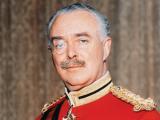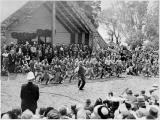George Grey
Personal details
Full Name:
George Grey
Lifetime:
14 Apr 1812 – 19 Sep 1898
Premier:
13 Oct 1877–8 Oct 1879
Age on becoming Premier:
65
Electorate:
Thames
Biography
Events In History
Grey played a central role in 19th-century New Zealand politics, serving two terms as governor before entering Parliament to fight Julius Vogel's plans to abolish the provinces. He was the first of just two men who have held both positions.
Governor George Grey led a small force that captured a Pai Mārire (Hauhau) pā at Weraroa, near Waitōtara. The pā had long lost its strategic significance, and its small garrison had seemed willing to surrender.
Lieutenant-General Duncan Cameron set out on what was to prove to be his final campaign in New Zealand with more than a thousand troops under his command.
The New Zealand Settlements Act enabled the confiscation (raupatu) of land from Māori tribes deemed to have ‘engaged in open rebellion against Her Majesty’s authority’. Pākehā settlers would occupy the confiscated land.
During his first term as governor, George Grey was praised for ending the Northern War and obtaining land from Māori, but he angered settlers by delaying the implementation of a constitution that would have given them some political power.
Governor Sir George Grey issued a proclamation to bring the New Zealand Constitution Act (UK) 1852 into operation, establishing a system of representative government for the colony.
The battle at Ruapekapeka (‘the bats’ nest’), a sophisticated pā built by the Ngāpuhi chief Kawiti, ended the Northern War. Debate soon raged as to whether the fortress had been deliberately abandoned or captured.
Articles
History of the Governor-General

New Zealand has had a governor or (from 1917) a governor-general since 1840. The work of these men and women has reflected the constitutional and political history of New Zealand in many ways. Read the full article
Page 4 - Responsible government
From the 1840s settlers demanded a say in government. Governor George Grey suspended an overly elaborate constitution in 1846, but the New Zealand Constitution Act 1852 gave male
Governors and Governors-General

New Zealand has had 16 resident governors and 22 governors-general. Two early governors were called governor-in-chief. Read the full article
Page 1 - Governors and governors-general
New Zealand has had 16 resident governors and 22 governors-general. Two early governors were called
Māori King movement - 1860-94

King Tāwhiao's reign was dominated by the Waikato War and the fallout from it. Read the full article
Page 2 - Build-up to war
Like his father, King Tāwhiao had no intention of becoming involved in the war in Taranaki. The government, however, remained unconvinced of this. In July 1860 Governor Gore
The Treaty in practice
Amalgamating Māori into colonial settler society was a key part of British policy in New Zealand after 1840. Economic and social change, along with land-purchase programmes, were central to this process. Read the full article
Page 1 - The Treaty in practice
Amalgamating Māori into colonial settler society was a key part of British policy in New Zealand after 1840. Economic and social change, along with land-purchase programmes, were
Page 2 - Slide to war
War raged in the North Island in the mid-19th century. The period from 1860, when conflict broke out in Taranaki, through to about 1872, is commonly called the New Zealand Wars.
Treaty timeline

See some of the key events between 1800 and 1849 relating to the Treaty of Waitangi. Read the full article
Page 1 - Treaty events 1800-49
See some of the key events between 1800 and 1849 relating to the Treaty of Waitangi.
The Northern War

The Northern War, fought in the Bay of Islands in 1845-46, was the first serious challenge to the Crown in the years after the signing of the Treaty of Waitangi. Its opening shots marked the beginning of the wider North Island conflicts that are often referred to as the New Zealand Wars. Read the full article
Page 6 - The quest for peace
George Grey became governor in November 1845. When talks with the 'rebels' broke down in early December, Grey ordered Despard to move against Kawiti's new pa,
Page 7 - Ruapekapeka
Ruapekapeka may have been a tactical victory for the British, but many consider the outcome a draw. Heke and Kawiti had escaped with their forces largely intact, and the terms of
Page 8 - Peace breaks out
Historian James Belich contends that Grey won the propaganda war and Kawiti and Heke won the real war. Others argue that Belich's revisionism goes too far and maintain that Grey's
War in Waikato
After fighting broke out again in Taranaki in early 1863, Governor George Grey turned his attention to the region he saw as the root of his problems with Māori: Waikato, the heartland of the anti-landselling King Movement. Grey vowed to ‘dig around’ the Kīngitanga until it fell. Read the full article
Page 2 - Invasion plans
Governor Gore Browne demanded that the Kīngitanga submit ‘without reserve’ to the British Queen and began planning an invasion of Waikato shortly before his reassignment to
War in Tauranga
During the first half of 1864 the focus of the New Zealand Wars shifted from Waikato to Tauranga. In this phase of the conflict the British suffered a catastrophic defeat at Pukehinahina – better known as the Gate Pā – before inflicting heavy losses on a Māori force at Te Ranga. Read the full article
Page 4 - Aftermath
British soul-searching after the defeat at Gate Pā did not acknowledge the superior tactics and capability of their












